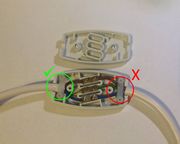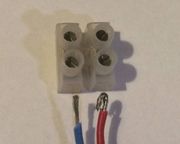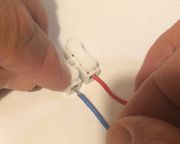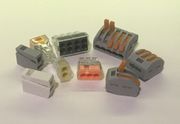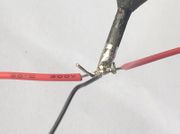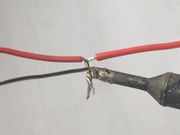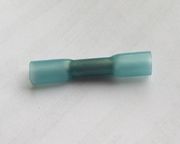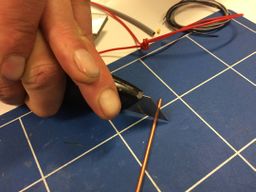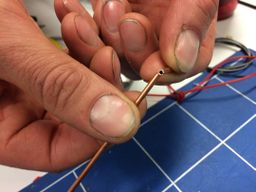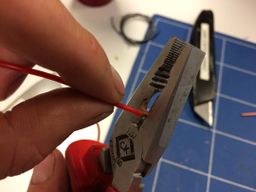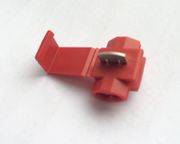Draden aansluiten en verbinden
Op deze pagina wordt uitgelegd hoe u draden veilig en betrouwbaar kunt aansluiten, splitsen of verbinden.
Samenvatting
Tijdens een reparatie moeten vaak draden worden aangesloten of opnieuw worden aangesloten. Misschien wordt een versleten flex vervangen of een defecte thermische zekering. Simpelweg de draden in elkaar draaien is bijna nooit een goed idee, maar er zijn verschillende andere manieren om dit te doen.
Als u regelmatig reparaties uitvoert, kan het nuttig zijn een paar connectoren van verschillende types in uw gereedschapskist te bewaren.
Veiligheid
- Waar de draden onder netspanning staan, is het essentieel dat de verbinding goed is geïsoleerd en dat de draden worden vastgeklemd om te voorkomen dat de verbinding onder spanning komt te staan.
- Zelfs als er geen netspanning op staat, kan een kortsluiting als gevolg van een niet-geïsoleerde verbinding schade veroorzaken aan andere onderdelen.
- Let erop dat een slecht gemaakte verbinding heet kan worden en zelfs brand kan veroorzaken.
Repareer het voordat het breekt!
Een veel voorkomende fout is een gebroken hoofdtelefoonsnoer op het punt waar het de connector binnenkomt. Als de buitenste isolatie begint te scheuren, heeft u geen tijd meer! Een eenvoudige oplossing is om het te repareren met Sugru. Dit is een kneedbare stopverfachtige vorm die binnen 24 uur uithardt tot synthetisch rubber. Giet een beetje rond de kabel om het beschadigde deel te beschermen, giet het op de connector om beweging te voorkomen en maak het geleidelijk dunner vanaf de connector, zodat de kabel niet scherp kan worden gebogen.
Schroef-, klem- en veerklemmen
Waarschijnlijk de oudste methode om een draad aan te sluiten is met een schroefklem. De schroefkop kan de draad direct of bij voorkeur onder een sluitring vasthouden, of de schroef kan de draad klemmen in een gat in een messing klem.
In het geval van gevlochten draad moeten de afzonderlijke draden na het strippen van de isolatie altijd bij elkaar worden gehouden door ze stevig in elkaar te draaien, of nog beter, door een beetje soldeer aan te brengen.
Zorg er in het eerste geval voor dat het blanke uiteinde van de draad ten minste lang genoeg is om een halve slag rond de schroef te maken, en wikkel hem altijd om de schroef in dezelfde richting als waarin u hem vastdraait.
Wanneer de schroef de draad in een gat n een messing terminal klemt, is het vaak nuttig om voldoende isolatie te strippen zodat u het blanke uiteinde dubbel kunt vouwen, zodat de schroef voldoende houvast heeft. U kunt ook soldeer aanbrengen op de draad.
Netkabels verbinden
De enige manier om twee flexibele netsnoeren veilig te verbinden is met een in-line schroefklemmenkast. Deze heeft aan elk uiteinde een kabelklem, die gebruikt moet worden om de buitenste isolatie vast te klemmen, niet alleen de binnenste draden.
Elektriciens gebruiken vaak een ronde aftakdoos zonder kabelklemmen, maar dit is alleen aanvaardbaar als alle kabels die erin gaan over hun lengte worden vastgezet met kabelklemmen, vaak gespijkerd aan een draagbalk.
Blokverbindingen
Deze worden geleverd in stroken die gemakkelijk kunnen worden afgeknipt afhankelijk van het aantal draden dat moet worden aangesloten. Ze zijn handig voor het aansluiten van laagspanningsdraden, maar bieden geen enkele vorm van kabelklem, dus mogen ze alleen voor het lichtnet worden gebruikt als u ervoor kunt zorgen dat de kabels niet gespannen kunnen worden. Ze bevatten een gat tussen elk paar connectoren, waarmee u ze op een stevige ondergrond kunt vastschroeven.
Chocoblokconnectoren zijn er in verschillende maten, zoals 3A, 5A, 15A enz., maar het enige belangrijke is dat ze groot genoeg zijn voor de draad, en nog belangrijker, dat de draad groot genoeg is om door de schroef te worden gegrepen. U kunt altijd wat extra isolatie strippen en de draad dubbelvouwen om de schroef meer houvast te geven.
Mits de ruimte het toelaat, kunnen deze connectoren nuttig zijn bij het vervangen van een thermische zekering die door de hitte van een soldeerbout zou kunnen doorslaan. U moet dan wel de behuizing verwijderen, die vaak van zacht plastic is en kan smelten voordat de thermische zekering doorbrandt.
Veerklemmen
Er zijn verschillende types van, en ze kunnen gebruikt worden om een snelle en gemakkelijke verbinding te maken zonder gereedschap (behalve het strippen van de isolatie). Ze worden vaak gebruikt voor luidsprekerkabels en in modeltreinstellen, en bieden een eenvoudige manier om zo vaak als nodig verbindingen te maken of te verwijderen. Het aanbrengen van soldeer op het blanke uiteinde van de draad is nuttig.
Wago connectoren zijn een veel voorkomende eigen vorm van veerverbindingen, verkrijgbaar in verschillende types. Ze zijn ontworpen voor het verbinden van twee of meer draden, voor netspanning of voor laagspanning. Sommige hebben een hendel om de veer op te tillen of in te drukken, maar bij andere duw je de draad er gewoon in en is er geen zichtbare manier om hem los te maken. De truc hierbij is om de draad heen en weer te draaien terwijl je er stevig aan trekt.
Soldering
Twisting the wires together and soldering is often the best method, but there are two ways of doing this. If possible, you should twist the wires in-line before soldering as this makes a stronger (and neater) join than twisting the ends together. This requires a greater length to be stripped of insulation and can be tricky if the wires differ in diameter, or if one is stranded and the other solid.
The wires need to be clean in order to make a good joint. A little extra flux from a flux pen never does any harm and often makes it easier if the insulation has not been freshly removed. In the case of enamelled wire, the enamel needs to be scraped or burnt off. If a little remains it often won't matter and may melt with the solder. In fact some wire enamels are "solder-through" and designed to melt with the solder, but an initial scrape to get it started usually helps.
Soldering headphone leads
Headphone leads use a special kind of ultra-flexible wire consisting of many individually enamelled strands of fine wire. The three connections for stereo headphones or four for a stereo headset use different coloured enamel. You will need to separate the strands of each colour.
The enamel may be designed to melt in the solder but it often helps to start it off by gently scraping with a knife, trying not to break any of the strands as you do so. Alternatively you may be able to burn off the enamel in a flame.
Heat shrink solder sleeves
A simple solution if you don't have a soldering iron handy is to use heat shrink solder sleeves. These contain a ring of low temperature solder in the centre of a heat shrink tube. Make sure the stripped ends of the wires are clean so as to accept the solder. Pass one wire in each end so that they cross over in the solder ring, then simply apply a heat gun. This simultaneously melts the solder and shrinks the sleeve to insulate the join.
Crimping
Crimping is both quick and easy, and makes a very reliable join, creating microscopic welds between the wire and the connector. But it does require the correct crimp connectors and crimping tool to make a good join. A crimping tool and a selection of crimp connectors are not expensive.
Crimp connectors come in several colour-coded sizes and it's important to use the right one. Too small and you won't be able to insert the wire, or too big and it may not be gripped properly. In addition to in-line connectors, an assorted set will usually contain a variety of spade, ring and bullet connectors as widely used in auto electrics.
Some crimp connectors such as the one illustrated have a heat shrink sleeve. This can be recognised by the noticeably larger diameter of the sleeve at the two ends. When shrunk with a heat gun this seals around the wires at each end (provided they're not too thin), giving extra protection to the two wires being joined.
Another type of crimp connector has a blind hole into which both wires to be joined are inserted together.
N.B. for safety, always give a crimp connection good tug after making it to ensure it's a good one.
DIY crimping
Standard crimp connectors most commonly come in the larger sizes used in auto electrics, but these may be too large for some of the wires used in domestic electrical appliances and gadgets. An example is if you need to replace a wire-ended thermal fuse in a hair dryer, steam iron or kettle. Soldering may not be advisable as the heat from the soldering iron may cause the replacement thermal fuse to blow.
An alternative is to use narrow gauge copper or brass tubing as available from model making suppliers. Choose a size into which the wire fits comfortably. Cut a short length by rolling it on a flat surface under the blade of a craft knife to score it and then snap it off. Insert one wire into each end and crush the tube onto each wire with a pair of fine-nosed pliers or blunt wire cutters (but if you use wire cutters, take care not to cut into the tubing).
N.B. The tug test is arguably even more important with a DIY crimp.
Insulation displacement connectors
Scotchlok connectors contain a piece of metal which cuts through the insulation and bites into the copper conductor. They are commonly used in auto electrics for splicing into power wires in order to supply after-market accessories. They contain two holes for two wires, one open at the side allowing it to be slipped over an existing wire, and the other a blind hole to take a lead to the accessory. Squeezing it with a pair of pliers causes the metal piece to cut through the insulation of both wires and make the connection. Folding over the flap allows you to lock it closed.
You could equally use one of these to connect the ends of two wires, but you must use the right size for the wires you are connecting in order for it to cut fully through the insulation whilst not damaging the copper wire inside.
Insulating your connections
Some types of connector are self-insulating, so long as none of the uninsulated wire is exposed, but with others you will usually need to provide some form of insulation.
- PVC tape is the simplest and easiest but not necessarily the neatest. NEVER simply bind up a cracked mains lead with PVC tape.
- Heat shrink sleeving is an excellent method. It comes in a variety of sizes and colours, pre-cut or in a continuous length. Choose a size which is no more than twice the diameter of the joint you need to insulate, and don't forget to slip it onto one of the wires before you join them! If soldering, keep it away from the iron. Once you're ready, slip it over the join and heat with a heat gun until it has fully shrunken. If you don't have a heat gun to hand, you can hold it very close above a soldering iron and it should shrink slowly, but be very careful not to let it touch the iron.
- Sugru can be used to insulate a join as described above, such as in a headphone lead, but don't rely on it alone to provide strain relief. If you need strain relief then one solution would be to knot the lead either side of the join to give the Sugru something to hold onto.
- The earth wire in the type of mains cables designed for permanent installation is often uninsulated. Green and yellow striped sleeving is available to slip over this within a mains socket or wall switch to prevent it touching a live connection. This will sometimes be useful in other circumstances, but avoid using it where might confuse the next repairer into thinking it's an earth wire when it isn't.
